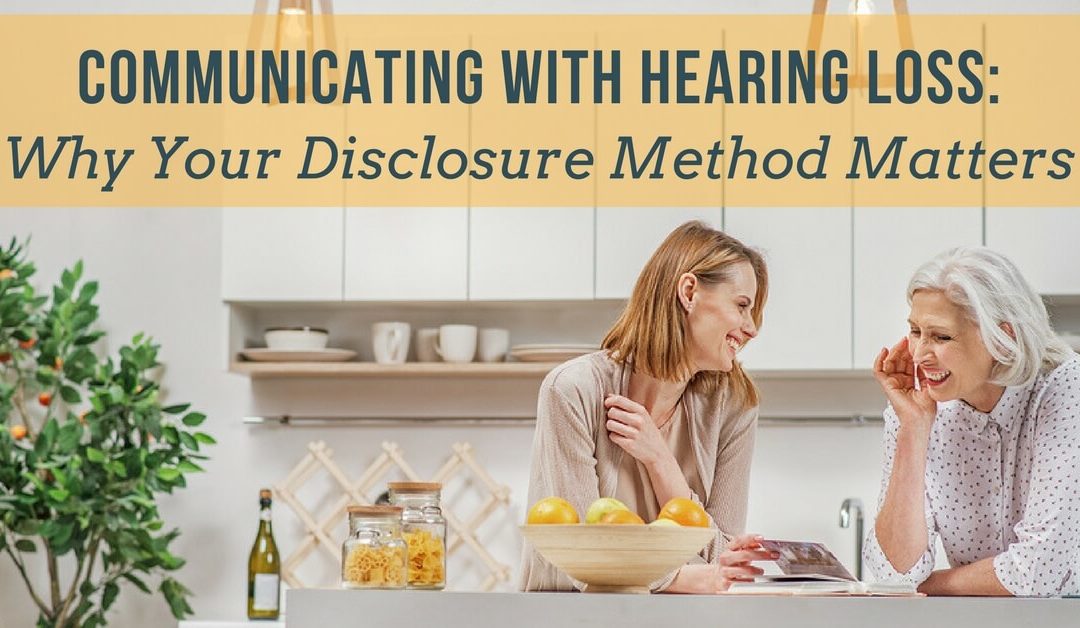Most of us understand the importance of communication in our relationships. An open channel of communication is the foundation of healthy relationships, and when we are unable to discuss feelings, problems, and solutions, relationships may break down.
Treating hearing loss is an important step for your overall health, and it also ensures that you are able to actively participate in your relationships. When it comes to hearing loss, we all have our own ways of processing the experience and how we want to talk about it with others. While there is no one right way to talk about hearing loss, there is one way that is more effective than others.
A Study on Hearing Loss Disclosure Methods
Published in March 2016 in the journal Ear and Hearing, “Revealing Their Hearing Loss: A Survey of How People Verbally Disclose Their Hearing Loss” studied the various ways in which people communicate their experience to others and the impact of their disclosure method. This study was conducted by researchers at Massachusetts Eye and Ear and involved 337 participants, who answered a short survey on how they disclose their hearing loss.
In analyzing survey results, researchers found that responses could be categorized into three main disclosure methods:
- Nondisclosure – “phrases that do not disclose hearing loss”
- Basic disclosure – “phrases that disclose hearing loss through the term, a label, or details about the condition”)
- Multipurpose disclosure – “phrases that disclose hearing loss and provide information to facilitate communication”
Within these groups, researchers found that multipurpose disclosers were “mostly female” and “had experienced reactions of help, support, and accommodation after disclosing.” As far as basic disclosers go, researchers found that they were “predominantly male” who “reported feeling somewhat more comfortable disclosing their hearing loss over time” and “had not experienced reactions of being treated unfairly or discriminated against.” Finally, people who did not disclose their hearing loss “tended not to disclose in a group setting” and “were diagnosed with bilateral hearing loss.”
Researchers hope that these results encourage hearing health care providers and patients alike to consider how their disclosure methods affect communication. According to Dr. Konstantina Stankovic, one of the senior authors of the study, “We think that it can be empowering for patients to know that these strategies and especially the multipurpose disclose strategy, are available to them.” Furthermore, she believes that the multipurpose disclosure strategy “may help them gain the confidence they need to disclose their hearing loss and improve communication with others.”
The Three Types of Disclosure Methods
Nondisclosure
With nondisclosure, people do not reveal any information about their hearing loss. If they have difficulty hearing in a conversation, nondisclosures might use phrases that people with normal hearing would use, such as “I didn’t catch that, could you repeat yourself?” or “Please speak up, I can’t hear you.”
Basic Disclosure
With basic disclosure, people will reveal minimal information about their hearing loss. They might say, “I have a hearing loss,” and leave it at that. Basic disclosers do not share details around their experience nor do they provide recommendations to improve communication.
Multipurpose Disclosure
With multipurpose disclosure, people will reveal that they experience hearing loss and provide their companions with recommendations for accommodation. For example, they may say, “I have a hearing loss, and I don’t hear as well from my right ear. Would you mind walking on my left side instead?” Researchers encourage people with hearing loss to adopt the multipurpose disclosure strategy for the benefits that it brings.
Prevalence of Hearing Loss
Due to surrounding taboos on hearing loss, people who experience it may want to avoid discussing it. The reality is, hearing loss is the third most common medical condition in the United States, affecting 20% of the population. It affects people of all ages, with an especially high concentration among older Americans, age 65 and above. One in three people age 65 or older experience hearing loss, while 50% of people over the age of 75 experience hearing loss. When hearing loss is treated, it brings significant benefits to one’s health and well-being.
The prevalent rates of hearing loss may help shatter some myths about hearing loss and encourage you to determine a way to communicate your experience. Though it is an entirely personal decision, the above study reveals that people who do decide to disclose their experience with hearing loss and provide their loved ones with gentle instructions on how to assist them in communication experience “help, support, and accommodation.”
As Helen Keller once said, “Blindness separates people from things; deafness separates people from people.” The same might be said of hearing loss – but it does not have to be so. Determining a way to disclose your experience with your loved ones and receiving support in return will help the way you communicate and it will also help your relationships stay strong.

